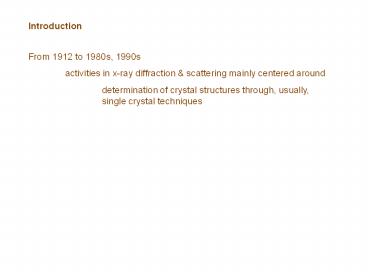From 1912 to 1980s, 1990s - PowerPoint PPT Presentation
Title:
From 1912 to 1980s, 1990s
Description:
(see Warren - X-ray Diffraction) shape of diffraction peak determined by ... in so-called Warren-Averbach method, deconvolution of observed maximum h(x) ... – PowerPoint PPT presentation
Number of Views:111
Avg rating:3.0/5.0
Title: From 1912 to 1980s, 1990s
1
Introduction
From 1912 to 1980s, 1990s activities in x-ray
diffraction scattering mainly centered around
determination of crystal structures through,
usually, single crystal techniques
2
Introduction
From 1912 to 1980s, 1990s activities in x-ray
diffraction scattering mainly centered around
determination of crystal structures through,
usually, single crystal techniques identifica
tion and quantitative analysis of unknowns,
principally using powder diffraction
techniques.
3
Introduction
From 1912 to 1980s, 1990s activities in x-ray
diffraction scattering mainly centered around
determination of crystal structures through,
usually, single crystal techniques identifica
tion and quantitative analysis of unknowns,
principally using powder diffraction
techniques. still important challenging
activities
4
Introduction
Recently x-ray diffraction techniques
increasingly applied to more difficult complex
areas, likely because of a. need to solve new
types of (non-routine) problems (e.g.,
disordered systems, interface structures, nano
materials, quasiperiodicity)
5
Introduction
Recently x-ray diffraction techniques
increasingly applied to more difficult complex
areas, likely because of a. need to solve new
types of (non-routine) problems (e.g.,
disordered systems, interface structures, nano
materials, quasiperiodicity) b. need to
examine structures new types of materials
(e.g., incommensurate materials, polymers,
quasicrystals)
6
Introduction
Recently x-ray diffraction techniques
increasingly applied to more difficult complex
areas, likely because of a. need to solve new
types of (non-routine) problems (e.g.,
disordered systems, interface structures, nano
materials, quasiperiodicity) b. need to
examine structures new types of materials
(e.g., incommensurate materials, polymers,
quasicrystals) c. development of better
instrumentation d. availability of highly
intense sources (synchrotron) e. availability
of immense computing power
7
Introduction
To understand how to apply x-ray diffraction to
these new areas (with, probably, many yet to
come) need to examine physics mathematics of
diffraction from basic, rather general
standpoint development of Cowley will be
followed - Fourier series, Fourier transforms,
convolutions employed
8
Introduction
Example calculation of crystallite size
microstrain from breadths of diffraction peaks
(this one is "old") (see Warren - X-ray
Diffraction)
9
Introduction
Example calculation of crystallite size
microstrain from breadths of diffraction peaks
(this one is "old") (see Warren - X-ray
Diffraction) shape of diffraction peak
determined by a. instrument source size and
geometry b. small crystallite size c.
non-homogeneous strain in the structure
10
Introduction
Example shape of diffraction peak determined
by a. instrument source size and
geometry b. small crystallite size c.
non-homogeneous strain in the structure before
size/microstrain analysis, instrumental
contribution to observed diffraction maxima
must be removed by deconvolution
11
Introduction
Example shape of diffraction peak determined
by a. instrument source size and
geometry b. small crystallite size c.
non-homogeneous strain in the structure before
size/microstrain analysis, instrumental
contribution to observed diffraction maxima
must be removed by deconvolution in so-called
Warren-Averbach method, deconvolution of
observed maximum h(x) h(x) ?(g(z) f(x-z)
dz performed by applying Stokes correction -
results in representation of size/strain
broadened peak by a series of Fourier
coefficients
12
Introduction
Example
(see Introduction to Quasicrystals, Jaric, ed.)































